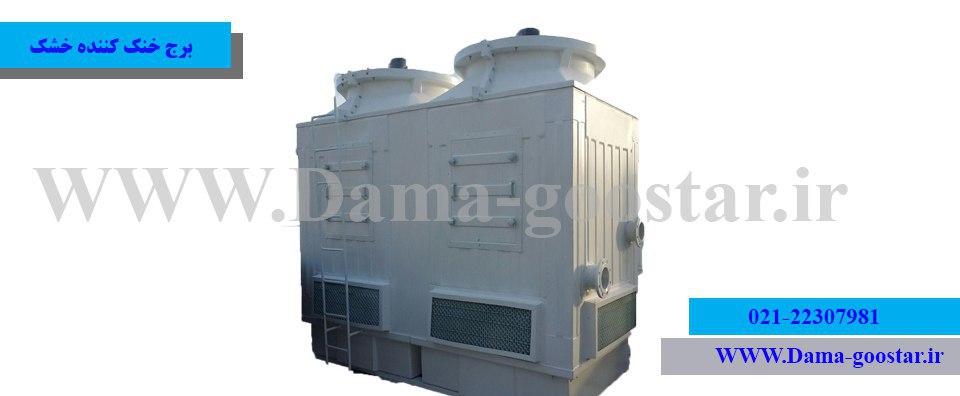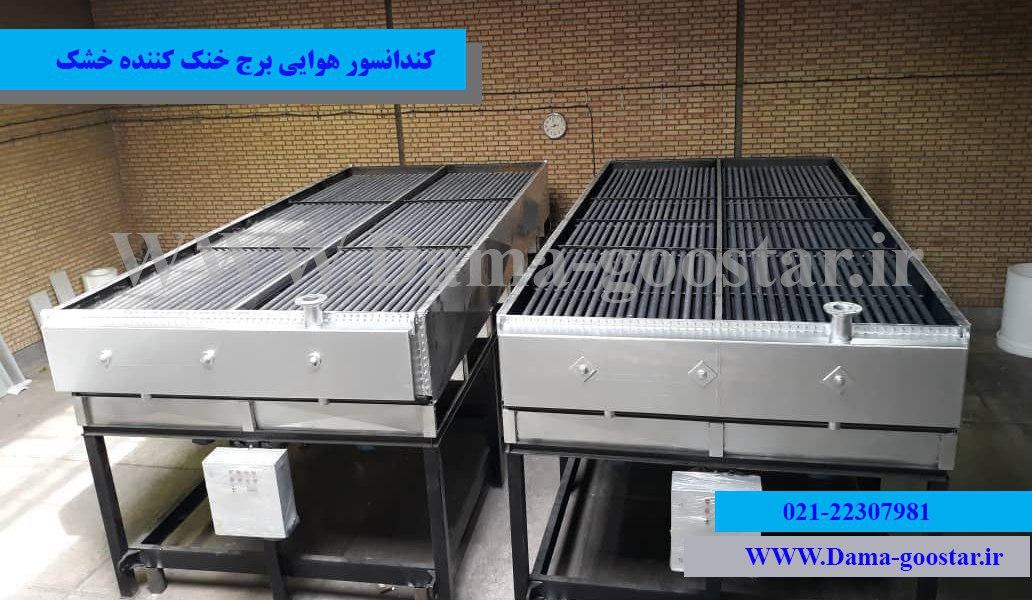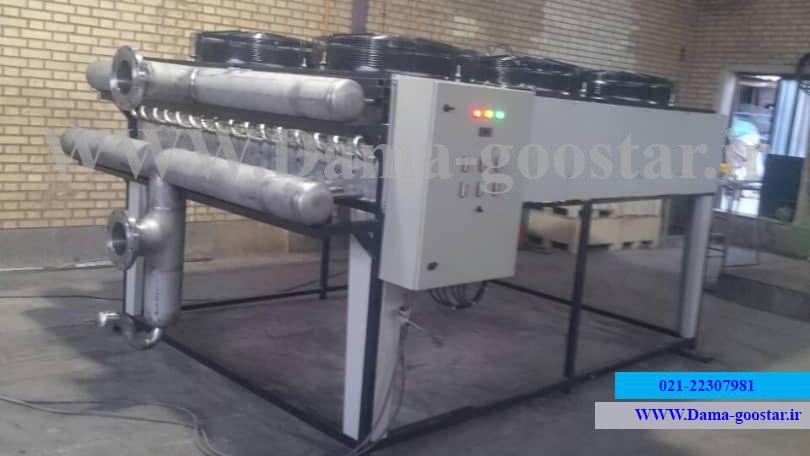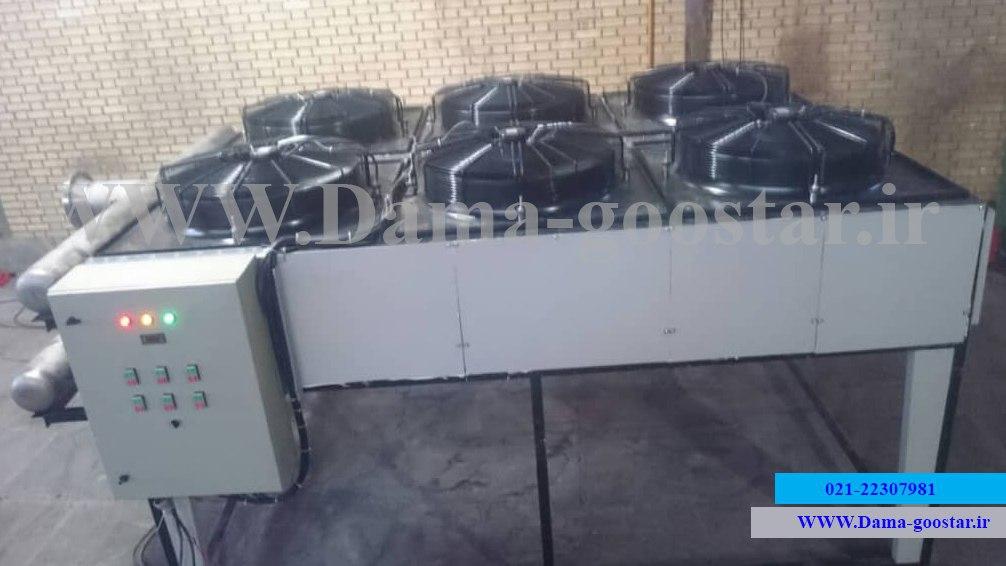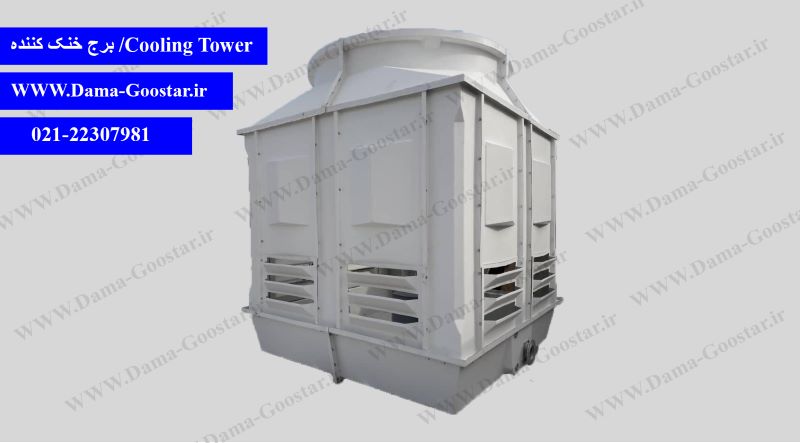برج خنککننده خشک (Dry Cooling Tower) نوعی کولینگ تاور با سیستم سیرکولاسیون آب به صورت مداربسته قلمداد میشود که جریان در گردش آب در چرخهی این مدل خنککن، داخل یک کویل(سطح تماس غیرمستقیم) جریان پیدا میکند و در تماس با جریان هوا خنک میگردد. سیستم خنککاری خشک به نوعی یک برج خنککننده مداربسته محسوب میشود که تماس بین آب و هوا در یک مدار غیرمستقیم صورت میپذیرد.
آیا برج خنککننده خشک برای همه مناطق مناسب میباشد؟
در پاسخ به این سوال باید بگوییم بلی، ولی این تجهیز بسیار مناسب مناطق کویری، خشک و سرد میباشد چرا که این دستگاه هیچگونه برخلاف برج خنک کننده مرطوب مصرف آبی نخواهد داشت و همچنین کاهش دما سبب افزایش راندمان آن خواهدشد. مناطقی همانند ارومیه ، تبریز، شیراز، مشهد وسایر شهرهای سرد و معتدل کشور بسیار مناسب این مدل سیستم خنک کاری در تجهیزات خود می باشد. حتی در مناطقی مثل یزد ، کرمان و اصفهان که با مشکل بی آبی و کم آبی مواجه می باشد برج خنک کننده خشک گزینه مناسبی جهت خنک کاری سیکل های صنعتی محسوب می شود.
برج خنک کننده خشک یا کندانسورهوایی ؟؟؟؟؟؟؟؟
در پاسخ به این سوال کلیدی باید مطرح کنیم هردو این واژه ها در واقع به یکی معنی می باشد. خنک کننده خشک بسیار شبیه یک مبدل حرارتی (Heat Exchanger) بین آب و هوا عمل می کند که به همین دلیل عملکرد این دستگاه به آن کندانسورهوایی(Air Condenser) نیز گفته میشود. به بیانی سادهتر برج خنک کن خشک یا کندانسور هواخنک متشکل از یک کویل و یک سیستم هوادهی میباشد که به جهت کاهش دمای آب گرم تا نزدیکی دمای خشک محیط به کار برده میشود.
مقایسه برج خنککننده خشک و مرطوب:
- کولینگتاور مداربسته خشک در واقع مصرف آب سیستم های برودتی را به شدت کاهش میدهد و برای نقاطی که تامین آب دشوار می باشد بسیار مناسب می باشد. در یک خنک کننده مرطوب آب در تماس مستقیم با هوا در بخش سطوح خنک کننده یا پرکن گرما از دست می دهد و این درحالی است که در برج خنک کننده خشک جریان آب در یک سیکل بسته (Close Circuit) در تماس با جریان هوای القایی فن قرار گرفته و در تماس با جریان القایی فن گرما از دست داده و دچار کاهش دما می شود.
- عملکرد برج خنک کننده خشک یا مداربسته وابسته به دمای خشک یا محسوس محیط (Dry Bulb Temperature) میباشد و این در حالی است که کوینگ تاور مرطوب وابسته به دمای مرطوب محیط(Wet Bulb Temperature) می باشد. در فصول گرم مانند تابستان دمای خروجی آب سرد برج خنک کن مداربسته خشک دچار افزایش می شود و خنکای قبل را ندارد و این موضوع سبب می شود در برخی از طراحی ها از ترکیب کولینگ تاور مداربسته و مدارباز همراه با هم استفاده گردد که در این حالت به این دستگاه برج خنک کننده هیبریدی نیز گفته می شود.
مطلب پربازدید سایت دماگستر: محاسبات برج خنک کننده
نحوه عملکرد برج خنککننده خشک
در یک کولینگ تاور مداربسته یا در اصطلاح برج خنککننده خشک، جریان آب وارد یک کویل (Coil) یا سطح مقطعی از لوله های مویین و باریک می شود و جریان هوا نیز در تماس با سطح بیرونی کویل قرارگرفته و این موضوع سبب جذب انرژی گرمایی از آب می شود.
بهتر است از کویل در طراحی کولینگ تاورمداربسته درون برج خنک کننده خشک استفاده نمایید.
کویل در یک خنک کننده خشک در واقع به مانند سطوح خنک کننده یا پکینگمدیا در سیستم مرطوب عمل مینماید. کویل شبکه ای از لوله های فین دار (Fin Tubes) یا بدون فین می باشدکه عموما دارای لوله هایی از متریال فلزی با ضریب انتقال حرارت بالا همانند مس ، آلومینیوم و استیل می باشد. در یک برج خنک کننده خشک این شبکه لوله بندی لوله های باریک (کویل) وظیفه ایجاد سطح نفوذ حرارتی (Conductivity) را برعهده دارد. جداره واسطه کویل در یک برج خنک کن خشک سبب بسته شدن سیکل و تماس غیرمستقیم دو سیال آب و هوا می شود .
آیا وجود فین در طراحی کویل در برج خنک کننده مداربسته خشک الزامی است؟؟
فین های به کار رفته در سطح بیرونی کویل در برج خنک کننده خشک با هدف ایجاد سطح انتقال حرارت بیشتر عموما از متریال آلومینیوم با قابلیت فرم دهی آسان به کار برده می شود. سطح ویژه کویل و همچنین تراکم فین در کویل سبب افزایش ظرفیت برودتی سیستم سرمایشی خواهدشد. محاسبه صحیح سطح ویژه لوله (tube) و فین (fin) در کویل مداربسته یکی از پارامترهای اساسی در چگونگی عملکرد خنک کن خشک دارد.
اجزای اصلی برج خنککننده خشک
کولینگتاور مداربسته به طور کلی دارای سه بخش اصلی و اساسی میباشد. بدنه و استراکچر نگهدارنده، کویل کندانسور و سیستم هوادهی شامل پروانه و الکتروموتور از اصلی ترین قطعات برج خنک کننده خشک محسوب میشود.
1-بدنه (body and Frame): بدنه در واقع استراکچر اصلی نگهدارنده دستگاه و شامل بخش های مختلف از جمله لوور(Louver) یا کرکره مکش هوا، فن استک یا عرشه فن (Fan Deck) ، تشتک (Basin) و پنل (Panel) یا دیواره و شاسی نگهدارنده کویل می باشد. در برخی از نمونه های برج خنک کننده خشک (برج مداربسته گالوانیزه) عموما از یک شاسی ساده جهت نگهداری کویل استفاده می شود و دیگر از تجهیزاتی همچون تشتک یا فن استک استفاده نمیشود. شرکت دماگستر با ارائه بدنه از متریال فایبرگلاس با کیفیتترین ایرکولرها و برجهای خنککننده خشک را ارائه می دهد.
نسل جدید برجهای خنککننده خشک با بدنه فایبرگلاس در واقع مقاومت بسیاربالایی در برابر اشعه نورخورشید و همچنین مقاومت بسیار بالایی در برابر رطوبت محیط دارد. همچنین جایگزینی فایبرگلاس در مقابل گالوانیزه سبب افزایش مقاومت بدنه در برابر پوسیدگی و خوردگی خواهد شد. کاهش وزن و قابلیت جابجایی و تعمیر و نگهداری آسان از دیگر مزایای بدنه فایبرگلاس برجهای خنک کننده خشک تولیدی شرکت دماگستر میباشد.
2-کویل (Coil): این بخش مهمترین بخش در سیستم مداربسته در سردکن خشک محسوب میشود و هدف کویل در کولینگتاور مداربسته در واقع ایجاد سطح نفوذ انتقال حرارت میباشد(همانند پکینگ برج خنککننده). به منظور افزایش راندمان برج خنککننده مداربسته مهمترین بخش انتخاب قطعات همین بخش می باشد. در واقع نوعیت جنس کویل، تعداد ردیفهای کویل، تراکم فین و تعدادلوله در ردیف تأثیر بسزایی در راندمان برج خنککننده دارد.
3-سیستم هوادهی ((Air Flow System : سیستم هوا رسانی سهم بسزایی در انتقال حرارت و انرژی گرمایشی را برعهده دارد. این بخش شامل فن یا پروانه ، الکتروموتور و سیستم انتقال قدرت میباشد. ایجاد جریان القایی در هوا و تماس این هوا با سطح جداره کویل مهمترین عمل در انتقال حرارت را صورت میدهد. بنابراین تنظیم میزان هوادهی تاثیر بسزایی در ظرفیت برج خنک کننده خشک خواهد داشت. قطرپروانه، تعدادپرههای فن و دور پروانه مهمترین عوامل تأثیرگذار بر میزان هوادهی میباشد.
بخش های مختلف سیستم هوادهی در برج خنک کننده خشک :
الف) فن یا پروانه: این بخش در واقع تامین کننده فشار نسبی در هوای اطراف و درنتیجه سبب جابجایی هوا (ایجاد جریان القایی) میگردد.
ب) موتور: این بخش تامین کننده انرژی مکانیکی جهت تأمین گشتاور مورد نیاز چرخش فن در برج خنککننده میباشد.
ج) سیستم انتقال قدرت یا کاهش دور: این بخش درواقع دور خروجی الکتروموتور را تا اندازه استاندارد دور فن در کولینگ تاور کاهش میدهد و تحت عنوان سیستم کاهنده دور برج خنک کننده شناخته می شود.
محصول پرفروش شرکت دماگستر: برج خنک کننده
مزایای برج خنک کننده خشک
- نگهداری و استفاده از این تجهیز بسیار مقرون به صرفه و کم هزینه(بدون مصرف آب)
- عدم ایجاد آلودگی های زیست محیطی از جمله افزایش رطوبت، کاهش میزان آب در سفره های زیرزمینی(به سبب نیاز نداشتن آب جبرانی)
- عدم رسوب پذیری و مشکلات آلودگی آب در کندانسور و نبودن نیاز به جرم گیری لوله های کندانسور به صورت دوره ای
- قابلیت کنترل میزان مصرف انرژی برق در بخش هوادهی و هوارسانی(کاهش هزینه های برق در فصول خنک)
- قابلیت حمل و جابجایی آسان به دلیل عدم گردش حجم آب زیاد در چرخه مداربسته
- تعمیر و نگهداری آسان به دلیل نداشتن رسوب، خوردگی و پوسیدگی
- قابلیت کاربری دو منظوره (هم سرمایشی و هم گرمایشی)
معایب برج خنک کننده خشک
افزایش دمای خروجی آب خنک در فصول گرم (به دلیل افزایش دمای محسوس محیط)
عملکرد ضعیف در فصول گرم در مناطق گرم و خشک در خنک کردن آب (راندمان پایین)
هزینه اولیه بالا به جهت استفاده از کویل (عدم صرفه افتصادی)
راندمان پایین تر نسبت به برج خنک کن مرطوب
حساسیت بالا در هنگام نصب و راه اندازی
نیازمند تجهیزات فرعی از جمله منبع انبساط، منبع تخلیه و پمپ ساکشن جهت آبگیری و تخلیه آب خنک در سیکل مداربسته
نکته مهم: با توجه به موارد ذکر شده توصیه میگردد سیستم برج های خنک کننده هیبریدی را در شرایط کمبود آب جبرانی استفاده نمایید.
انواع برج خنک کننده خشک
کولینگ تاور مداربسته خشک از لحاظ جنس بدنه کندانسور و متریال لوله های کویل به دسته بندی های متفاوتی تقسیم می شود. خنک کن مداربسته به لحاظ جنس بدنه در دو تیپ کلی بدنه فلزی و بدنه کامپوزیتی تولید و عرضه می شود. برج خنک کننده فایبرگلاس خشک در واقع فقط در تیپ مکعبی تولید می شود و دلیل این موضوع استراکچر مکعبی شکل ساختار کویل می باشد. کولینگ تاور خشک با بدنه فایبرگلاس در مقابل آسیب های محیطی دارای مقاومت بیشتری نسبت به خنک کننده گالوانیزه می باشد.
در انتخاب جنس کویل در طراحی برج خنک کننده خشک دقت نمایید.
کویل خنک کن خشک در متریال های متنوع از جمله مس، استیل 304 ، استیل 316، استنلس استیل، استیل کربن، فولاد API و لوله مانسیمان بدون درز تولید و عرضه می گردد. با توجه به شرایط سیال یعنی میزان خورندگی، املاح موجود در سیال و سایر پارامترها کویل نیز از جنس های مختلف در طراحی سیستم مداربسته پیشنهاد می گردد. به عنوان مثال برای خنک کردن آب نرم بهترین گزینه در انواع برج خنک کننده خشک ، کویل مسی با ضریب کانداکتیویتی بالا می باشد و این درحالی است که برای خنک کردن اسید و یا سیالات اسیدی بهترین گزینه کویل استیل SS316 می باشد. البته برای آب های با سختی بالا (دارای نمک) بهترین گزینه برای متریال کویل استیل SS304 می باشد.
مقرون به صرفه ترین انتخاب کویل در برج خنک کننده خشک
مناسبترین جنسیت کویل به لحاظ قیمت اولیه برای خنک کردن آب کویل گالوانیزه (بدون درز و درزدار) می باشد. به دلیل پایین بودن ضریب نفوذ حرارتی این فلز عموما کویل با این نوع فلز از متراژ های زیاد لوله گالوانیزه در طراحی کولینگ تاور مداربسته استفاده می شود. از نوع لوله بدون درز در زمانی استفاده می شود که فشار جریان آب درگردش در سیکل بسته بیشتر از 3 بار باشد.
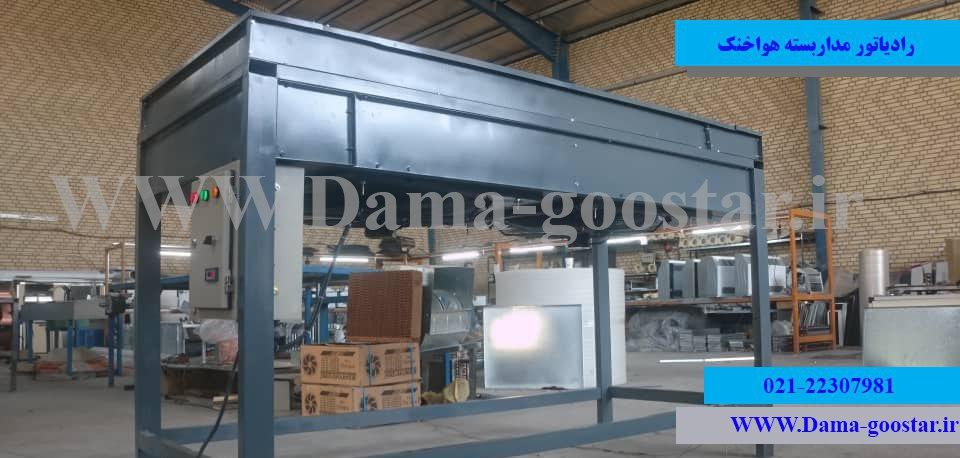
قیمت برج خنک کننده خشک
برج خنک کن مداربسته به مراتب قیمت بالاتری نسبت به انواع کولینگ تاور مدارباز یا مرطوب دارد. قیمت این مدل سردکن بسته وابسته به عوامل متعددی همچون ظرفیت برودتی، جنس کویلو جنس بدنه متغیر می باشد. بنابراین پارامترهای متعدد و بیشماری در تعیین قیمت تاثیرگذار خواهد بود . بالاترین قیمت برج خنک کننده خشک یا مداربسته متعلق به سیستم خنک کاری با کویل استنلس استیل SS316 می باشد. طراحی کولینگ تاور خشک با کویل مسی از نظر قیمت نهایی در رده بعدی قرار دارد ولی از طرفی به دلیل ضریب نفوذ حرارتی بالا و قیمت مناسب، این تجهیز یکی از پرفروش ترین محصولات برج خنک کننده محسوب می شود.
عوامل تاثیرگذار بر قیمت برج خنک کننده
حنس کویل به کار رفته در سیکل بسته در کولینگ تاور مداربسته
ضخامت لوله ها (Tube thickness)
قطر لوله ها و متراژ لوله به کار رفته (Tube OD)
ضخامت فین ها(Fin thickness)
متریال شاسی اصلی نگهداری کویل و متریال بکاررفته در تیوب شیت ها
ضخامت بدنه و استراکچر اصلی فایبرگلاس یا فولاد ورقکاری شده
توان الکتروموتور سیستم هوادهی و همچنین نوع پروانه به کار رفته در این بخش
در واقع عوامل فوق پارامترهای اساسی تعیین نرخ قیمت در برج خنک کننده خشک محسوب میشود که البته لازم به ذکر است عوامل دیگری نیز همچون بالانس استاتیکی و دینامیکی پروانه، نوع IP محافظتی موتور، عایق حرارتی موتور ، برند موتور و نوع تست جوش و تست فشار در کویل تاثیر بسزایی در قیمت نهایی برج خنک کن خشک خواهد داشت.
نواسانات قیمت در بازار مواد اولیه =عدم ثبات قیمت برج خنک کننده
قیمت برج خنک کننده خشک با توجه به نواسانات دائمی بازار مس ، استیل و همچنین الیاف و رزین بکاررفته در بدنه فایبرگلاس دائما دچار نوسان خواهد بود. واحد تولیدی شرکت دماگستر از ارائه لیست قیمت کولینگ تاور به دلایل فوق الذکر معذور می باشد. پیشنهاد می شود به منظور برآورد قیمت دقیق این گونه خنک کننده های صنعتی با کارشناسان شرکت تماس حاصل نمایید و پس از طراحی و محاسبه میزان سطح ویژه کویل و ظرفیت برودتی این دستگاه، نرخ قیمت برآوردی را به صورت مکتوب وشفاهی دریافت نمایید.
